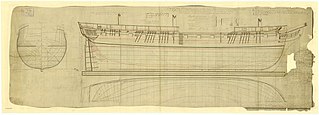
HMS Saldanha was a 36-gun fifth-rate Apollo-class frigate of the Royal Navy. She was commissioned in April 1810 and spent her entire career serving on the Irish Station, including capturing a fast-sailing French privateer on 11 October 1811. In the evening of 4 December that year Saldanha was serving off Lough Swilly when she was caught in a storm. Last seen sailing off Fanad Head, the ship was wrecked in a nearby bay with every person on board being killed and the only survivors being a parrot and a dog. The wreck was memorialised by Thomas Sheridan in his poem The Loss of the Saldanha.

Rear-Admiral Lord Adolphus FitzClarence was a British Royal Navy officer and illegitimate son of Prince William, the future William IV, and his mistress Dorothea Jordan. FitzClarence joined the navy in 1813. In the following year he joined a fourth rate which saw service in the War of 1812, including in the unsuccessful blockade and chase of USS Constitution. FitzClarence saw frequent service in the Mediterranean Sea. Coming under the patronage of Rear-Admiral Sir Thomas Fremantle, FitzClarence received further naval education from Commander William Henry Smyth and served in the Ionian Islands upholding British neutrality in the Greek War of Independence.

The Pallas-class frigates were a series of three frigates built to a 1791 design by John Henslow, which served in the Royal Navy during the French Revolutionary and Napoleonic Wars.
HMS Bristol was the name ship of her class of wooden screw frigates built for the Royal Navy during the 1860s.

HMS Pallas was one of the three 36-gun Venus-class fifth-rate frigates of the Royal Navy. She was launched in 1757 and initially served in Sir Edward Hawke's fleet blockading the coast of France where she fought at the Raid on Cherbourg and in the Battle of Bishops Court. She later served for a number of years in the Mediterranean Sea before moving to serve off the coast of Africa between 1774 and 1776 where she protected the isolated British colonies. In 1778 she joined the Newfoundland Station and participated in the attack on Saint Pierre and Miquelon. Pallas returned to the English Channel after this and assisted in destroying a French invasion force intended for the Channel Islands in 1779 before briefly serving on the Jamaica Station. In 1783 she was beached on São Jorge Island after she was found to be heavily leaking; she was burned there on 24 February.

HMS Brilliant was a 36-gun Venus-class fifth-rate frigate of the British Royal Navy that saw active service during the Seven Years' War with France. She performed well against the French Navy in the 1760 Battle of Bishops Court and the 1761 Battle of Cape Finisterre, but was less capable when deployed for bombardment duty off enemy ports. She also captured eight French privateers and sank two more during her six years at sea. The Royal Navy decommissioned Brilliant in 1763. The Navy sold her in 1776 and she became an East Indiaman for the British East India Company (EIC). Brilliant was wrecked in August 1782 on the Comoro Islands while transporting troops to India.

HMS Andromeda was a 32-gun Hermione-class fifth rate frigate of the Royal Navy. She was laid down in 1781 and launched in 1784. She was commissioned for the first time in 1788 when Captain Prince William Henry took command of her and sailed for the West Indies. Prince William Henry paid her off in 1789 and she was not commissioned again until 1790 in response to the Spanish Armament. In 1792 Andromeda joined the Royal Navy's Evolution Squadron in the English Channel before sailing for the Leeward Islands where she stayed until the end of 1793 when Captain Lord Northesk brought her home. She was refitted for much of 1794 before in September joining the Downs Station. Captain William Taylor assumed command in 1795, briefly sailing her to Newfoundland before returning to the North Sea Fleet in 1796. She stayed here for 3 years, seizing the 36-gun Batavian frigate Zefir in the Firth of Forth in March 1798 and participating in the Raid on Dunkirk in July 1800. After another period of service in the Leeward Islands Andromeda returned home at the Peace of Amiens and was laid up at Portsmouth Dockyard where she was broken up in September 1811.
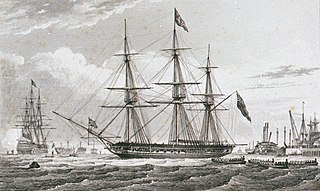
HMS Royal Sovereign was one of the royal yachts of King George III. She was the largest of his yachts and served from 1804 until she was broken up in 1849.

HMS Aigle was a 36-gun, fifth-rate frigate of the Royal Navy. Ordered on 15 September 1799 and built at Bucklers Hard shipyard, she was launched 23 September 1801. More than fifty of her crew were involved in the Easton Massacre when she visited Portland in April 1803 to press recruits. Her captain and three other officers stood trial for murder but were acquitted. Much of Aigle's career as a frigate was spent trying to keep the English Channel free of enemy warships and merchant vessels. On 22 March 1808, she was first into the action against two large French frigates, compelling one to seek the shelter of the Île de Groix batteries and forcing the other onto the shore.

HMS Sylph was a 16-gun Albatross-class brig-sloop of the Royal Navy designed by William Rule and launched in 1795 at Deptford Dockyard. Her namesake was the air spirit sylph. She commissioned in August 1795 under Commander John Chambers White, who would have her until the end of 1799. She was later commanded by Charles Dashwood.
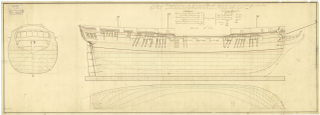
The Thames-class frigate was a 32-gun fifth-rate frigate class of eight ships of the Royal Navy based on the Richmond-class frigate designed by William Bately. The ships were ordered to the older design, which was of a smaller type of ship compared to more modern designs, so that they could be built quickly and cheaply in time to assist in defending against Napoleon's expected invasion of Britain. The class received several design changes to the Richmond class, being built of fir instead of oak, with these changes making the class generally slower and less weatherly than their predecessors, especially when in heavy weather conditions. The first two ships of the class, Pallas and Circe, were ordered on 16 March 1804 with two more ordered on 1 May and the final four on 12 July. The final ship of the class, Medea, was cancelled on 22 October before construction could begin but the other seven ships of the class were commissioned between 1804 and 1806.

HMS Jason was a 36-gun fifth-rate Penelope-class frigate, launched in 1800. She served the entirety of her career in the English Channel, mostly in the frigate squadron of Commodore Charles Cunningham. Serving off the coast of France, especially around Le Havre and Cherbourg, she captured several French privateers and recaptured a British merchant ship in a cutting out expedition. Having only been in commission for around fifteen months, Jason was wrecked off the coast of St Malo on 21 July 1801. Her crew were saved and later exchanged, and in August her wreck was burned to prevent the French from rescuing it.

HMS Beaulieu was a 40-gun fifth-rate frigate of the Royal Navy. The ship was laid down in 1790 as a private enterprise by the shipwright Henry Adams and purchased by the Royal Navy in June of the same year. A well-armed and large ship, Beaulieu was built to the dimensions of a merchant ship and did not have good sailing qualities. Commissioned in January 1793 by Lord Northesk, the frigate was sent to serve on the Leeward Islands Station. She participated in the capture of Martinique in February 1794, and then was similarly present at the capture of Saint Lucia in April. The frigate also took part in the start of the invasion of Guadeloupe. Later in the year the ship's crew was beset by yellow fever and much depleted. Beaulieu was sent to serve on the North America Station to recuperate, returning to the Leeward Islands in 1795. In the following two years the ship found success in prizetaking and briefly took part in more operations at Saint Lucia. She returned to Britain at the end of 1796.
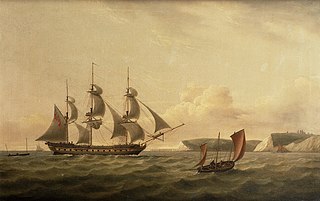
HMS Hussar was a 38-gun fifth-rate Amazon-class frigate of the Royal Navy. Launched at the end of 1799, the entirety of the frigate's career was spent serving in the English Channel and off the coast of Spain. Hussar primarily served as a convoy escort and cruiser, in which occupation the frigate took several prizes, including the French privateer Le General Bessieres. Towards the end of 1803 Hussar was sent to serve in Sir Edward Pellew's Ferrol squadron. On 8 February 1804 Hussar was returning to England with dispatches when the ship was wrecked off the coast of Île de Sein. The crew attempted to sail for home in a fleet of commandeered boats, but the majority were forced to go into Brest to avoid sinking in bad weather, where they were made prisoners of war.

The Perseverance-class frigate was a 36-gun, later 42-gun, 18-pounder fifth-rate frigate class of twelve ships of the Royal Navy, constructed in two batches. Designed by Surveyor of the Navy Sir Edward Hunt the first iteration, consisting of four ships, was constructed as a rival to the similar Flora-class frigate. Strongly built ships, the Perseverance class provided favourable gunnery characteristics and was highly manoeuvrable, but bought these traits with a loss of speed. The name ship of the class, Perseverance, was ordered in 1779 and participated in the American Revolutionary War, but her three sister ships were constructed too late to take part. The class continued in service after the war, but soon became outdated.

HMS Resistance was a 36-gun fifth-rate Aigle-class frigate of the Royal Navy, one of a pair designed by Sir John Henslow. Resistance was commissioned in May 1801 by Captain Henry Digby, and after brief service in the English Channel the frigate left for Quebec in charge of a convoy. While on voyage Resistance captured the French privateer Elizabeth, which was the last ship captured during the French Revolutionary War. Having returned to England at the end of the year, the frigate resumed service in the English Channel, with Captain Philip Wodehouse replacing Digby. On 31 May 1803 Resistance was sailing to the Mediterranean Sea when she was wrecked off Cape St. Vincent; the crew survived.
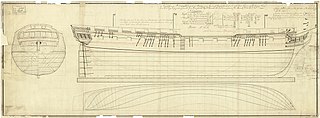
Aigle-class frigates were 36-gun sailing frigates of the fifth rate designed by Surveyor of the Navy, Sir John Henslow for the Royal Navy. Only two were built: HMS Aigle and HMS Resistance. Aigle was ordered first on 15 September 1798 but a 16-month delay during her construction meant that Resistance was completed and launched first on 29 April 1801.

HMS Manilla was a 36-gun fifth-rate Apollo-class frigate of the Royal Navy. Commissioned by Captain George Seymour in September 1809, Manilla's first service was in a squadron operating in the Tagus. She conveyed Lieutenant-General Sir John Sherbrooke to Halifax, Nova Scotia, in late 1811, returning to England with Lieutenant-General Gordon Drummond.

HMS Blanche was a 36-gun fifth-rate Apollo-class frigate of the Royal Navy. She was commissioned in 1800 by Captain Graham Hamond, under whom on 2 April 1801 Blanche fought as part of the frigate reserve at the Battle of Copenhagen. She spent the remainder of the French Revolutionary Wars serving in the English Channel. When the Napoleonic Wars began in 1803 Blanche was sent to serve in the West Indies under the command of Captain Zachary Mudge. There the frigate participated in the Blockade of Saint-Domingue and an unsuccessful invasion of Curacao, capturing upwards of twenty-four vessels.

HMS Stag was a 36-gun fifth-rate Apollo-class frigate of the Royal Navy. Commanded by Captain Phipps Hornby for almost her entire career, Stag began her service in the English Channel, capturing two ships in 1813. Mid-way through the year the frigate was sent to join the Cape of Good Hope Station, where she stayed until November 1814. At the Cape Stag formed part of the search for the wreck of the merchant ship William Pitt in Algoa Bay, and then spent time surveying the Bird Islands, of which one was subsequently named after the ship. After returning from the Cape, Stag was laid up at Plymouth Dockyard. She was moved to Sheerness Dockyard in 1821, where after an aborted refit the frigate was broken up.
















